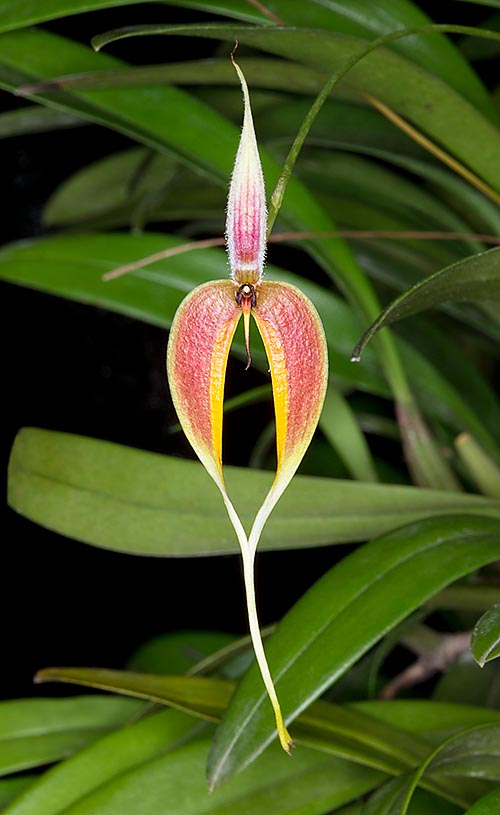Family : Orchidaceae

Text © Pietro Puccio

English translation by Mario Beltramini

Bulbophyllum maxillare is an Australian and South-Asian epiphyte © Giuseppe Mazza
The name of the genus is the combination of the Greek substantives “βολβός” (bolbos) = bulb and “φύλλον” (phyllon) = leaf, with reference to the leaves growing at the apex of the pseudobulbs; the name of the species is the Latin adjective “maxillaris” = maxillary, relevant to the maxilla, with reference to the shape of the sepals.
The Bulbophyllum maxillare (Lindl.) Rchb.f. (1861) is an epiphytic plant with ovate, grooved pseudobulbs spaced of 2-5 cm on a creeping rhizome, 3-4 cm long and about 0,8 cm broad, with at the apex one single, linear-lanceolate with pointed apex, 12-15 cm long and 2-2,5 cm broad leaf, on a 2 cm long petiole.
Lateral inflorescences from the base of the pseudobulb, up to 20 cm long, carrying one single flower with lanceolate dorsal sepal with pointed apex and ciliate margins, 2,5-3,5 cm long and 0,4 cm broad, of purplish red colour, ovate-lanceolate lateral sepals, slightly falcate and long pointed, up to 6 cm long and 0,7 cm broad, of purple red colour with yellowish margin and apex, ovate, falcate petals, 0,6 cm long and 0,2 cm broad at the base, and linear labellum with long pointed apex, about 0,7 cm long, of brown red colour.
It reproduces by seed, in vitro, and division, with each section provided of at least 3-4 pseudobulbs.
It requires very luminous position, but not on direct sun, except possibly that of the first hours of the morning, medium-high temperatures, 22-36 °C in summer, 15-26 °C in winter, high constant humidity, 70-90%, with always moving air. The watering must be frequent during the vegetative period, more spaced in winter, but without ever allowing the substratum to dry up completely. For the watering and the nebulisations is to be used rain water, by reverse osmosis or demineralised; the fertilizations, properly distributed in function of the vegetative status of the plant and alternate, in way to avoid salts accumulation at the roots, are to be preferably done with hydrosoluble balanced products, with microelements, at ¼ of the dosage suggested on the package. It can be mounted on rafts of arborescent ferns or arranged in pots or baskets, also suspended, rather wide thus to allow the rhizomes to freely elongate, with particularly aerated and draining substratum which may be formed by medium sized bark with addition of agri-perlite and fragments of charcoal and possible sphagnum, in order to maintain a bigger humidity, if the ambient is dry. The repotting are to be done when strictly necessary by the vegetative restart, signalled by the appearance of the new roots.
The species is reported in the appendix II of the CITES (species whose trade is ruled at international level).
Synonyms: Ephippium ciliatum Blume (1825); Cirrhopetalum blumei Lindl. (1830); Cirrhopetalum maxillare Lindl. (1843); Bulbophyllum cuspidilingue Rchb.f. (1861); Phyllorchis maxillaris (Rchb. f.) Kuntze (1891); Phyllorkis blumei Kuntze (1891); Phyllorkis maxillaris (Lindl.) Kuntze (1891); Bulbophyllum masdevalliaceum Kraenzl. (1904); Bulbophyllum blumei (Kuntze) J.J.Sm. (1905); Bulbophyllum ephippium Ridl. (1907); Ephippium masdevalliaceum (Kraenzl.) M.A.Clem. & D.L.Jones (2002).
→ For general notions about ORCHIDACEAE please click here.
